Monday was my last full day at Bamfield, and man, how quickly did those weeks go by! I felt like I had just started getting to know the people and the place and it was time to pack up and leave! Luckily, I got to spend my last day diving, so I couldn’t ask for anything better. Chad wanted to do two exploratory dives to look for Giant Pacific Octopus (GPO) dens. The upcoming week, a group was coming out who wanted to film the octopus, so he wanted to scope out some locations beforehand. We managed to find a tender to drive us out to the Ross Islands to do one of the dives, where we searched and searched for 50 minutes but couldn’t find any signs of a den (you look for piles of crab shells, favorite prey of GPO).

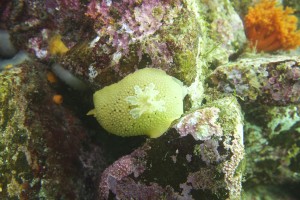
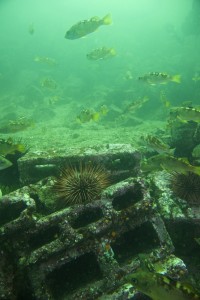

We headed back to the station to dive off the dock for our second dive, because there was rumor of a GPO den somewhere around the dock. Again, we searched and searched but only saw nudibranchs, rockfish, and sculpins. No signs of octopus. Although we didn’t accomplish our goal, it was awesome to finish my trip to Bamfield with two dives (that also had surprisingly good visibility!).

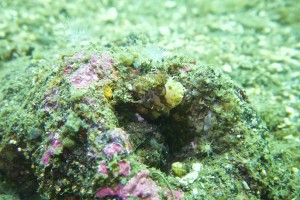
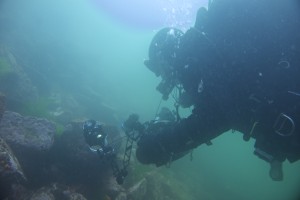
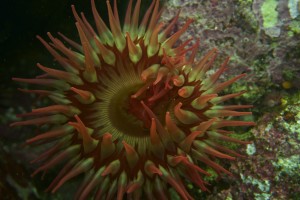
After spending the evening packing my bags and getting ready to leave, I headed to the lab one last time to help Sara feed fish and monitor temperatures. We powered through all the work because we wanted to do a sunset paddle (we also were finally having beautiful sunsets again!) So we hurried over to Seaside to gather Chad and Ian (one of the TAs) to make it on the water in good time. We grabbed kayaks and a canoe and set out to the channel in time to get some amazing pictures of my last Bamfield sunset. It was so fun to spend that time on the water, laughing and racing around in our canoe/kayaks.
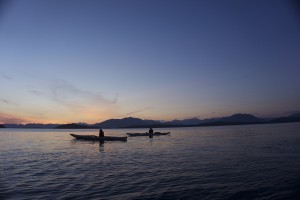
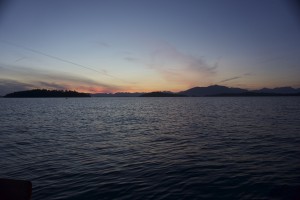
Tuesday came much faster than I wanted, but it had to happen and I was officially leaving Bamfield. I finished packing my bags, made my rounds of saying goodbye, then set out with Elena, who was driving to Victoria that day and offered me a ride. It took about 2 hours or so to get to Nanaimo, where I’d catch the ferry back to Vancouver. I was sad to leave Bamfield, but excited for the new adventure in store. I was spending the next few days with the Vancouver Aquarium, learning about various diving projects as well as how they use their exhibits as a means to educate the public about the marine world. Jeremy Heywood, the DSO, had invited me out for a few days and I jumped at the chance to learn more about the aquarium industry. After catching the late afternoon ferry to Vancouver, Jeremy met me at the terminal and I spent the night with him and his family in North Vancouver.
Wednesday was my first day with the aquarium, and Jeremy had made plans for us to go out diving with the Howe Sound research group to visit a site they were monitoring. I didn’t know what to expect, but was happy to be getting in the water so soon! We first headed to the aquarium to do some paperwork and get my dive gear sorted and by 9:30 am the truck was loaded and we were on our way to the marina to get diving! We loaded the research boat and headed out to Defense Island, where we’d be checking out a glass sponge bioherm. This site is of particular interest because normally these glass sponge bioherms are found at much deeper locations (300 feet or more) but for some reason, there were are few bioherms in Howe Sound at recreational depths (around 90 feet). We reached the island, set the anchor, then headed down to check out the sponges. I wasn’t sure what to expect, but from the surface, I thought it was going to be a dismal dive. The water was murky and bright teal from a nearby river running off into the sound, but once we descend past 25 feet or so, the visibility completely cleared up and I was pleasantly surprised at how ideal conditions were at depth. We quickly found the lines that led us to the bioherm and spent 20 minutes or so moving around and checking out the intricate glass sponges. They were so delicate but served as habitat for a variety of shrimps and fish, and I was taken aback by how complex the system was. I was honored to have the chance to check out such a unique ecosystem. After surfacing from the dive, we motored over to a second dive site, the recently sunk Annapolis, a Canadian destroyer that was put to rest in about 120 feet of water. We took just a short dive on the wreck, but it was amazing! Full of neat swim throughs and it’s not every day you can dive on a wreck that was only recently sunk. By the time we finished the second dive, we had to motor back to the marina as it was late afternoon and everyone needed to get back to the aquarium to wrap up their day. Once we unloaded the boat, I was “transferred” from Jeremy to Amy, an executive administrative assistant at the aquarium and an AVID diver. She had offered to host me for the next few nights and I would be going home with her. But before we would get to her apartment, we were headed to the Marine Mammal Rescue Center, where Amy volunteers every Wednesday night. We would spend the four hours from 6-10pm helping care for baby harbor seals that had been abandoned by their mothers earlier that summer. It was hard work, you were constantly cleaning up seal poop and they weren’t the most cooperative of creatures, but it was an awesome experience for me. I saw the real work that goes into caring for these creatures, which is a lot more hands-on and time intensive than people realize. We finished our day around 10pm and finally headed back to Amy’s apartment. It had been a long day with the Vancouver Aquarium, but a good start to my short trip in Vancouver.
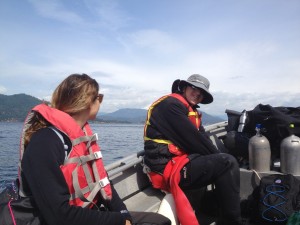
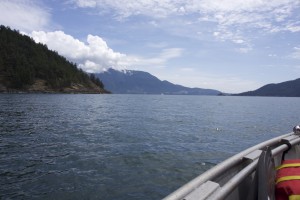
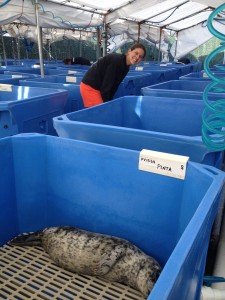
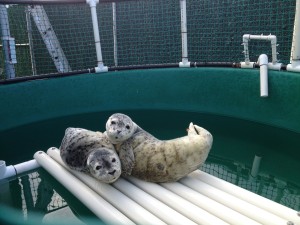
Thursday was another day of diving, but this time with the BC Waters team from the aquarium. They needed to go out for a collection dive, so I was invited to tag along. Amy dropped me off at the dive locker at the aquarium and I helped Jeremy load up the truck for the day. We would be going with two of the divers from the BC Waters team, doing 2 dives total, but only one per buddy pair. We headed to a different marina, as we were using a different research boat for the day, and once it was loaded with all our gear, we headed out for a location called Caulfeild’s Cove, where we’d be looking for swimming scallops mainly. We reached the site and threw down the anchor. The two divers from BC Waters were headed in first, so Jeremy and I tended the boat while they were down collecting. After about 40 minutes, they resurfaced at the boat with goodie bags full of seapens, sea cucumbers, crinoids, and only one swimming scallop. Jeremy and I then geared up and hoped in. This dive was vastly different from the two yesterday. We descended down a small rocky wall to a sand flat that sloped up to about 40 feet. We scoured the area for swimming scallops, but none could be found. We did manage to gather a few more sea pens, but by the time we had jumped in, the current had picked up quite a bit and we ended our dive after 30 minutes or so. Although we hadn’t managed to find what we were looking for, that’s the way it goes with collection dives. You often come back empty-handed and just have to keep trying until you’re successful. We got back to the aquarium in the late afternoon and after rinsing/hanging my dive gear, I met up with Amy at her office. She took me for a tour of all the aquarium exhibits, showing me her favorite tanks and giving me the chance to see the aquarium in its entirety. It’s a well done aquarium, with a variety of exhibits showcasing marine environments from around the world. I found the BC Waters exhibits to be my favorite though, as they were incredibly well done tanks that showed the best of the variety of marine environments in British Columbia. I thought they served well to show the public that the marine environment in the cold northern waters is just as colorful and diverse as the tropical reefs.
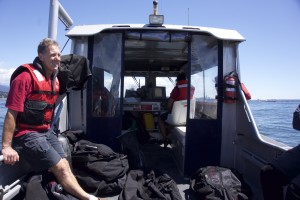
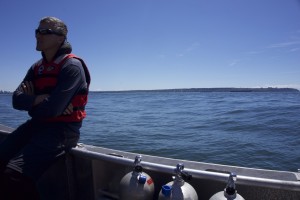
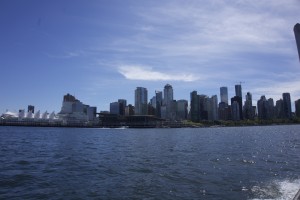
I was scheduled to spend the whole day on Friday shadowing members of the Interpretive Team at the aquarium and experience a day in the life of the staff that bridges the gap between the exhibits and the guests. I met up with Alex in the morning, who is the team leader for the “Interps” as thy call themselves. Our first task for the day was giving a small presentation about scuba diving to several summer camp groups at the aquarium. We got all the props and set up the slideshow. I watched as Alex gave his 20-minute presentation to about 75 kids, aged 6-11, in a way that made it easy and fun for them to understand. The kids had chances to ask questions and try on gear. Once we finished with that, we put back all the props and headed to the outside tanks to watch the 15 minute talk about Chester, the rescued false killer whale that calls the Vancouver Aquarium home. The Interps have the job of educating the public about the variety of marine species found at the aquarium as well as the conservation and protection work they do, and Chester is a perfect example of both, having been rescued and raised from a 2-week-old infant. After the talk was finished, we headed to the dive locker as Alex was the dive tender for one of the exhibit dives. We met up with the diver, helped her gear up, then headed to the giant Strait of Georgia exhibit, where she was diving. One interp was narrating from the floor in front of the aquarium and the diver would be using an OTS Full Face Mask to speak with the audience while she dived. Alex and I stood just at the top of the giant tank in the middle of the aquarium, keeping an eye on the diver and helping maneuver the cord that connected her communications with the microphone system that allowed the public to hear her. After the 20-minute presentation, we headed back to the dive locker to rinse down the dive gear and by this time, it was just past noon and we were ready for a lunch break. After lunch, I headed out to watch Alex give his presentation about Helen, the white-sided Pacific dolphin who was also rescued by the aquarium over 10 years ago. At the end of his talk, I met up with Jeremy, who took me over to do a quick interview for the aquarium’s blog, then Jeremy took me on a tour of the “behind the scenes” at the aquarium, where I saw just how intricate the exhibits really were and how much maintenance is required to keep all those tanks running smoothly. After my tour, I met Alex up in the shark penthouse, where he was doing the shark exhibit dive and I’d be helping feed the aquarium’s giant green sea turtle. Alex then continued my behind the scenes tour, showing me the sea lions that the aquarium uses for a variety of research projects as well as where some of the research teams are located, and we popped out just in time to catch the beluga show. After the 15 minute educational program, I went back to the Strait of Georgia exhibit where Dan was doing a fish feed and talking to the public about who eats what and how the aquarium keeps their critters full and happy. It was a day full of running around and meeting a whole lot of people, but I learned so much about the ways the aquarium is trying to use their exhibits to educate the public, which is right up my alley! I really was given a good look into the lengths the aquarium goes to to go above and beyond being an aquarium, and how it’s invested in research, conservation, and protection of the local BC waters. After a hectic but incredibly fun day with the Interp team, I met back up with Amy, gathered all my dive gear, and we headed out to a local shore diving site to do a fun dive of our own! We met up with a dive friend of Amy’s, Mike aka the Octopus King, at Kelvin Grove, a stunning wall dive that was a favorite among local divers. We geared up and headed down to the shore entry, where we waded in and wasted no time getting underwater! We descended down a beautiful rocky wall and just cruised. We all took our time looking around and searching for cryptic creatures in the rock crevices. It was an amazing dive, so relaxing and peaceful. We saw a great display of typical BC creatures – swimming scallops, sponges, anemones, grunt sculpins, ling cod, sailfin sculpins, and best of all. . . a Giant Pacific Octopus (spotted by Mike, of course)! My trip to Canada was complete – I had seen a GPO in the wild and I was happy as a clam. We surfaced after over an hour of ideal diving, and I couldn’t have asked for a better dive to finish my time in BC. We loaded the cars up and headed back to Amy’s apartment, where I slept soundly after such a wonderful day.
Check out my feature in the Vancouver Aquarium blog! http://www.aquablog.ca/2015/07/our-world-underwater-scholarship/
Saturday gave me a chance to sleep in but also catch up on a bit of work. I had made plans to spend the weekend with Chad at his family’s dairy farm in Surrey, a town just outside of Vancouver and while he spent the morning working on repairing his truck, I got to pack up gear, work on some expense reports, and send quite a few emails. Chad picked me up that afternoon and we drove to his farm, where I got to see all the dairy cows and the cute calves! After a relaxing afternoon of hanging out, I got a good night of rest before my journey to Washington the next day.
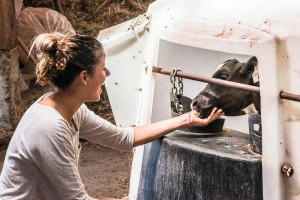
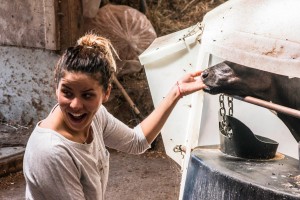
I spent Sunday morning looking at the cute calves again (I couldn’t resist the little guys!) and getting ready for my bus ride down to Anacortes, where my next adventure awaited me. Chad drove me to the Greyhound station (but not before we found a Tim Horton’s to give me one last taste of Canadian culture) and before I knew it, I was on my merry way back to the US of A! It was an easy 3-hour bus ride down to my next destination, where I’d be spending a week with the 1999 NA Rolex Scholar, Julie Barber, doing geoduck surveys for the Swinomish tribe.